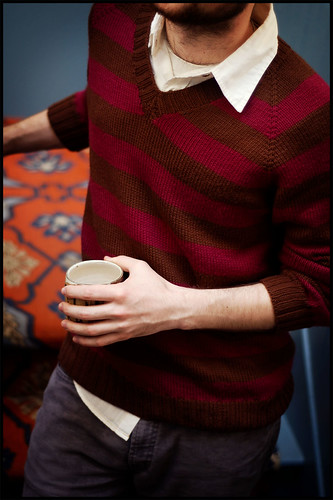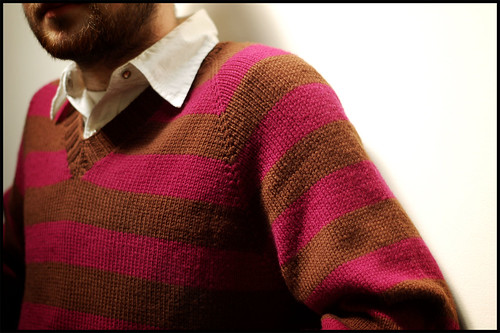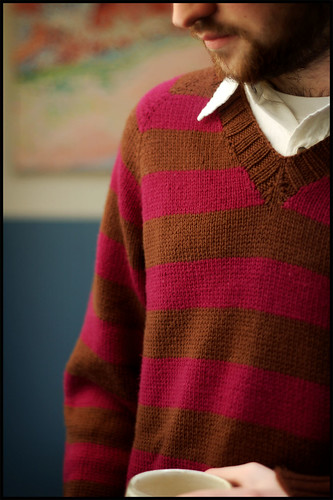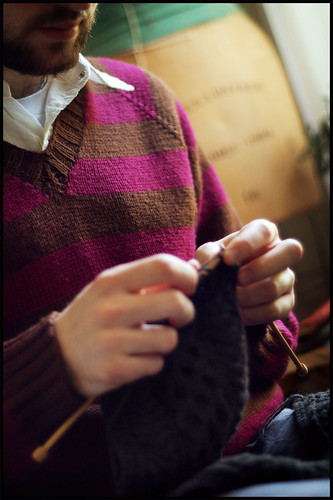
Pattern: Top Down Raglan Recipe
Source: Knitting From the Top by Barbara Walker
Size: 43" Chest Circumference
Materials: KnitPicks Swish Superwash Worsted (100% Superwash Wool)
Amount: 6 balls "Bordeaux" & 7 balls of "Truffle" (finished sweater weighs 650g)
Started: December 2006
Finished: May 2008

Barbara Walker is right up there with Elizabeth Zimmermann as one of the veritable forces of nature in the recent-history of our craft. Aside from her most well-known contribution and complete re-invention of the stitch dictionary, she is also credited with exploring, dissecting, and propagating knitting from the top down, not just sweaters mind you - hats, dresses, pants and more! Her book is a classic and comes highly recommended from me. She is truly a wonder.

If you've never knit a sweater from the top down, you must try it. My very first sweater was knit in this manner,and I've always had a fondness for it. Aside from one minor drawback, it's full of all kinds of advantages, the most valuable being absolute control over length in body and sleeves and the try-on-as-you-go possibility. As you're knitting, you can don your garment as many times as you need in order to get your lengths just right before that final bind off. (In fact, you could technically knit the sweater whilst wearing it, as exhibited on the book's cover, although I don't recommend it.) (Yes, I tried) If your sleeves grow after washing, just rip out the bind off, tear back an inch and bind off again. It's all very convenient. The drawback? The sweater gets a little cumbersome and large towards the end, when you're finishing off that last sleeve you may get a little tired of flipping the whole thing around as you're knitting. I think, though, that this is a completely reasonable price to pay for the obvious benefits of top-down knitting (intuitive points, check).
[EDIT] Awesome tip left in the comments by Miss Sandra - after finishing the yoke, knit the sleeves first. When you're ready to start the body, tuck the sleeves inside the yoke to minimize all those awkward appendages while turning your knitting. It won't change the weight of the garment, but will definitely help with the cumbersome aspects of maneuvering your sweater. (Thanks, Sandra!) Also I forgot to mention, EZ recommends (in Knitting Workshop) to keep the bulk of the garment in a canvas or cottan bag as you work for ease of turning.

I think the main reason for the long lull between start and finish on this project was primarily a materials issue. As far as superwash wools go, I think Swish is a pretty good one - where softness is concerned, it's wonderful (baby knitting heaven) - but I've realized over the years that I'm not a big superwash man. Back in 2006 I think I was still optimistic, but in the end I prefer my wools to be as sheepy and woolly as possible. When wool fibers are treated to be washable they lose some of the qualities that I'm most drawn to and since knitting, for me, is very much about the tactile experience, these material choices really make a difference in how fast or slow a project goes. (I think I have some cotton projects that may never rise from their half finished states. They're really old.)

My sweater grew slightly after washing . When I swatched (waaay back then), I washed and dried in a machine and had a shrinking of row gauge. So when I decided that I'd just wash it by hand like I do with all my other sweaters, I was caught off guard when the thing grew a bit upon drying. This little surprise turned out to be a blessing in disguise - the yarn gets über soft upon washing, and the fit was slightly baggier than I'm used to, the sleeves just a little longer than normal - turns out it's one of the coziest ones in my collection now and I've been wearing it a lot (those days are over now, 95 degree forecast for the weekend. Blargh.)
[EDIT] I forgot again to mention something important about my stripes! This info is also true for my striped vest, as I seemed to get a lot questions about jogs with that project as well. In all of my striped projects, assuming I'm working with only 2 colors, I employ this technique for jogless stripes and carry the unused yarn along the inside of the garment, wrapping the colors around each other at each color-change to catch the unworked yarn and keep things clean on the inside. There are no extra ends to weave in, and the beginning of the round is almost completely invisible on the RS of the fabric.

All in all, I'm really happy with how this turned out - while I don't love knitting with superwash, i do like wearing it. Also, it's definitely an interesting wardrobe item color-wise. And speaking of color - I apologize for the slight deviation in color-correctness from photo to photo. Magenta and warmish brown really like to trick my camera!
Up next, a ginormous wool blanket that can swallow people whole. Not kidding.
0 comments:
Post a Comment